While C&C did not invent the racer/cruiser, the Canadian-based company remained dedicated to the concept of the dual-purpose boat during its halcyon days in the seventies and eighties of the last century. With the notable exception of a few pure cruisers—the relatively low-performance Landfall series in 35, 42, 43, and 48, and a racer-based cruising boat (the Landfall 38), and a real oddball (the Mega 30)—most C&Cs paid at least lip service to modern trends in racing boats.
In some cases, C&Cs boats were closely designed to the racing rules. The C&C 38 was a somewhat modified older IOR (International Offshore Rule) one-tonner. The later C&C 41 was a development of several C&C custom IOR boats. And the C&C 37+ was designed to be competitive under the International Measurement System (IMS) handicapping rule.
Some 200 C&C 40s were built, and many of them did a lot of racing. It’s not unusual to find a 40 with very complete electronics, a full hydraulic rig control package, and a big inventory of racing sails. Since the designs days as a serious racing boat are pretty much over—although you can certainly compete at the local level—many owners interested in racing have unloaded C&C 40s at near fire-sale prices.
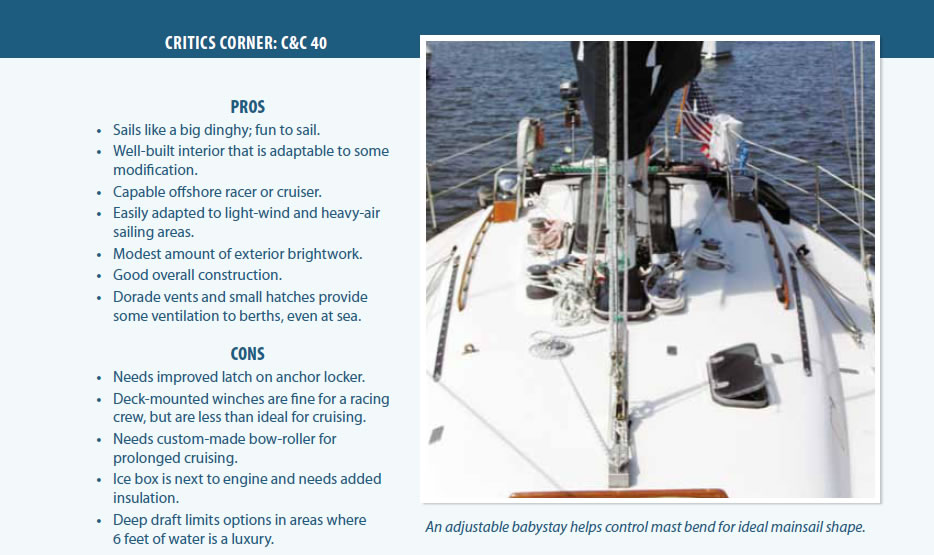
In general, the C&C 40 is a well-built boat, in the same class as other boats from the company. The construction is not particularly high-tech, however, and some boats may have suffered under the strains of very heavy racing.
In particular, wed recommend careful examination of the hull bottom in the way of the keel, and the attachment of structural components in the way of the mast and rudder.
Newer designs from C&C have taken advantage of higher-tech materials such as molded interior and hull support modules, and in general are probably stronger per pound of structural weight than older boats such as the C&C 40.
Nevertheless, a C&C 40 that surveys cleanly can be an excellent value for club racing, and-with some re-working of the deck layout-for shorthanded cruising in areas where the deep draft is not a problem.
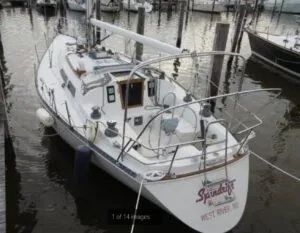
A 40-FOOTER BECOMES A MAINSTAY
The C&C 40 entered production as a 1978 model and was phased out in 1983, replaced by the higher-performance C&C 41—a bigger, much faster, slightly lighter, and more powerful boat. When it was rolled out, the 41 managed to come in cheaper than its C&C 40 progenitor.
While the 40 was an IOR design, it was not heavily optimized to the rule. In the late 1970s, custom IOR designs featured not only somewhat tortured hull shapes to fool the rule into thinking they were slower than they were. In many cases, they had grapefruit-sized bumps at critical measurement spots. By comparison, the hull of the C&C 40 was undistorted, fair, and conservative.
This lack of distortion was reflected in the boat’s IOR rating. A reasonably optimized custom 40-foot IOR design of the late 1970s rated about 10 feet lower than her overall length. The C&C 40, at 39.6-feet long, typically rated from 29.5 to 30.5, depending on the keel and rig configuration of the boat. Continued below/

The company was initially formed through the merger of several Canadian boat builders: Belleville Marine Yard, Hinterhoeller Ltd., Bruckmann Manufacturing, and the design firm of Cuthbertson & Cassian Ltd., with the aim of creating a powerhouse in sailboat design and manufacturing. C&C Yachts quickly established itself as a builder of high-performance sailboats made of fiberglass, offering a range of sailing cruisers and racing boats that varied in size from 21 feet to 67 feet. The company was known for its innovative designs, including the introduction of fiberglass sailboats, which marked a significant advancement in the industry.
The 1970s were particularly successful for C&C, as it became one of the largest sailboat builders in the world. However, the company faced challenges in the 1990s, including a devastating fire in 1994 at its Niagara-on-the-Lake (NOTL) plant, which led to significant financial losses and eventually the closure of the plant in 1996. Following the closure, C&C Yachts went through a series of ownership changes. In 1997, a joint venture was formed with Tartan Marine, leading to the development of new C&C models, including the C&C 99, 110, and 115, which were well received in the market. However, the early 2000s brought further challenges, and in 2013, US Watercraft announced it had acquired the rights to the C&C brand from Tartan. Unfortunately, US Watercraft entered receivership in 2017, ceasing all operations by the summer of 2018, marking the end of C&C Yachts’ production under that ownership.
Despite these challenges, the legacy of C&C Yachts lives on through the continued presence of its boats in the sailing community. The company’s innovative designs and contributions to the sailboat industry have left a lasting impact, with many of its vessels still actively sailed and cherished by enthusiasts around the world. Tartan Yachts, having acquired C&C in the late nineties, experienced success with the brand, launching nearly 400 Tartan-built C&C’s over a 10-year production run before eventually licensing the C&C brand to another builder. Today, C&C Yachts remains a symbol of quality and performance in the sailing world, with a rich history that reflects the evolution of sailboat design and manufacturing.
[/su_box]
With a rating as high or slightly higher than that of custom boats, which most likely were lighter and had better weight distribution, the C&C 40 was reasonably competitive under the IOR in her first year, marginally competitive by the second, and a good club-level racer by 1980. Top-flight IOR boats then had a serious competitive life of two years or less, which was a major factor leading to the near-demise of the rule.
Fortunately for the C&C 40, the Measurement Handicap System (MHS, later renamed the IMS) began to grow in popularity after 1980, giving the boat a new lease on competitive life, at least at second-echelon levels of competition. The boat was handicapped fairly by IMS, which meant it would do neither better nor worse racing under the rule than the crew sailing it.
This boat has good all-around performance upwind and downwind, in both light and heavy air. Despite a wide maximum beam, the boats ends are fairly well balanced, and the rudder was deep enough to stay in the water in all but a flat-out broach.
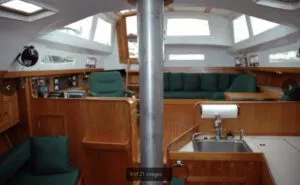
CONFIGURATIONS
You’ll find a number of different keel and rig combinations in the C&C 40. As designed, the boat has a high-aspect-ratio fin keel drawing 7 feet, with an I (height of foretriangle) dimension of 53 feet. This configuration is reasonable for all-around performance, but is a little lacking in power for lighter air. A rig 2 feet taller was introduced, and to increase sail-carrying ability, it was usually coupled with a 4-inch deep, 300-pound lead shoe bolted to the bottom of the keel. Stability of the two versions was virtually identical: The addition to righting moment from the shoe was almost exactly offset by the heeling moment of the taller rig.
The tall-rig, deep-keel version is on the average about three seconds per mile faster than the standard rig, standard keel model.
With a draft of 7 feet or more, the C&C 40 is not a boat for gunkholing, nor is it a good cruiser for areas of shallow water. A keel/centerboard variation was also built, drawing about 4 feet, 9 inches with the board up, 8 feet, 6 inches with the board down. To maintain the same stability as her deeper-draft sisters, the centerboard boat carries an additional 885 pounds of ballast, making her noticeably slower in light air. The IMS velocity prediction program showed the standard rig, centerboard model to be about four seconds per mile slower than the standard-keel, standard-rig version in 8 knots of breeze. In 16 knots of wind, all three configurations are virtually identical in speed.
In areas traditionally known for heavy air, a keel-shoe coupled to the standard rig has proven to be a powerful and competitive combination.
RACING PEDIGREE
Like many IOR boats from the mid- and late 1970s, the C&C 40 has a very high-aspect-ratio mainsail: about 3.5:1 with the standard rig, almost 3.65:1 with the tall rig. The result is a mainsail of just over 300 square feet, but a 100-percent foretriangle of about 440 square feet. This means lots of headsail changes, since reefing the mainsail has relatively little impact on total sail area.
With a racing crew of eight, headsail changes are no big deal. However, for a cruising couple, wrestling down a No. 1 genoa of over 650 square feet are no fun. For shorthanded cruising, a modern headsail furling system is an absolute must. We’d also forget the 150- percent genoa for cruising, using a 130-percent genoa—about the size of a racing No. 2—which can be effectively reduced to about 100 percent. It’s not realistic to expect more reduction from a single sail. In winds of 10 knots or more, the loss in speed from the smaller genoa is virtually meaningless when cruising: The C&C 40 is still faster than 90 percent of the 40- footers out there.
RIGGED RIGHT
C&C rigs are generally well designed, with masts of reasonably high-performance characteristics. This allows good mast control for racing. Tensioning the babystay pulls the middle of the mast forward, flattening the mainsail in heavy air. With all the shrouds in a single plane, the mast can assume a fair bend from top to bottom.
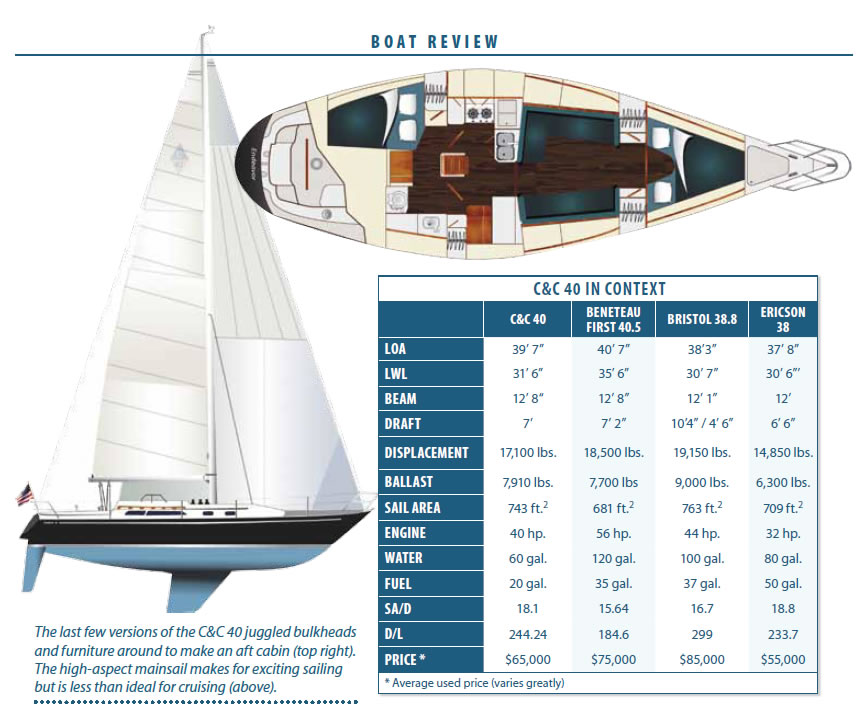
Most of these boats are equipped with a hydraulic backstay, with the babystay adjusted by a traveler on a track mounted atop the cabin. Boats that have been set up for racing may also have hydraulics for the babystay and vang. Without hydraulic mast controls, it’s virtually impossible to take advantage of the spar’s sail-shaping capabilities.
If you intend to use the boat only for cruising, and you install a headsail furling system, it would be almost imperative to add an inner forestay, particularly if youre headed offshore. The existing staysail track in the middle of the foredeck is not really strong enough for the attachment of a true heavy-weather staysail or storm jib.
The deck layout is definitely designed for racing. Halyard and spinnaker gear winches are mounted atop the deckhouse, aft of the mast. This works fine on a racing boat, keeping the center of gravity low, making it possible for one person to jump the headsail or spinnaker halyard while another tails, out of the way, further aft.
For shorthanded cruising, however, mast-mounted winches are superior. When reefing the mainsail with mast-mounted winches, one person can ease off the halyard, hook in the reefing tack, crank down the clew, and grind up the main halyard, all without moving. With deck-mounted winches, its back and forth between the mast and the deck if one person has to do the whole job.
YANMAR 3QM-30 or WESTERBEKE 30
Several different engines were used in the C&C 40. Early models usually had a Yanmar 3QM-30. Later boats typically were fitted with a Westerbeke 30, although some boats were equipped with the more powerful VW-based Pathfinder engine. The VW engines are expensive to maintain, and a timing belt failure can cause severe damage so if there is any doubt about the condition of the belt, replace it, and continue to replace it every 1,000 hours.
All the engines are capable of driving the boat to hull speed in calm water.
The engine is mounted under the bridgedeck, just below the companionway. You must remove the companionway ladder and the front of the engine box to get access to the front of the engine. You can get at the port side through the quarterberth.
The boat handles extremely well under power, thanks to a big rudder well aft, very little wetted surface, and a propeller mounted just forward of the rudder. Most boats are equipped with Martec folding props for racing-not the best installation for handling in reverse-but since the propeller is so far aft, the boat handles very predictably when moving astern. For cruising, we would rather see a feathering prop, which is an expensive but worthwhile retrofit.
BELOWDECKS
C&C never skimped on the interiors of its racer/ cruisers, and the 40 is no exception. The interior is built up of teak-faced ply, rather than incorporating a fiberglass liner with molded furniture bases.
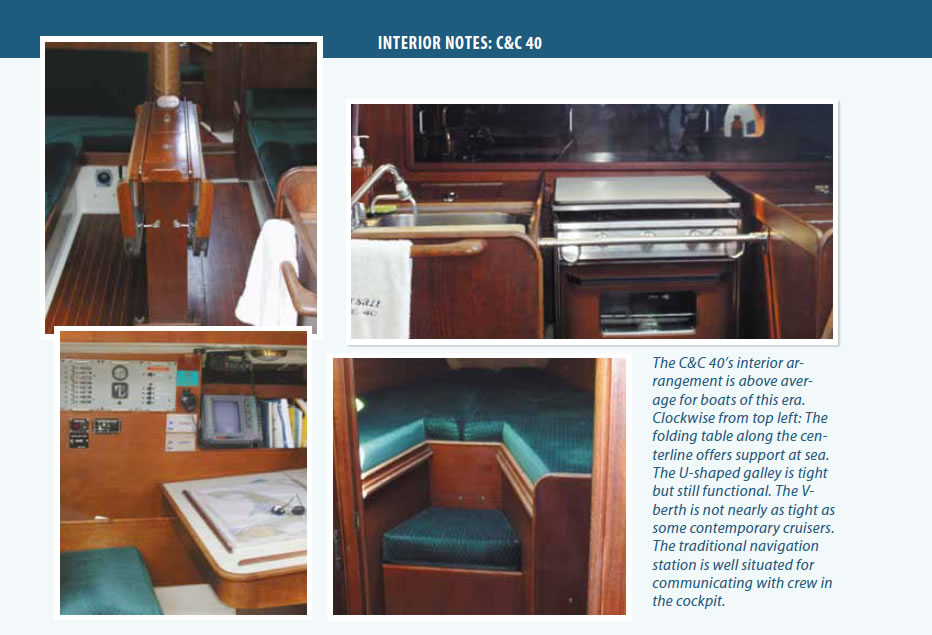
The oiled teak ply makes for a darkish interior, which could be lightened considerably by varnishing both the ply and its solid teak edging. A nice combination is to use satin finish varnish on the ply, glossy varnish on the solid teak trim. This is time consuming, of course, but it can noticeably brighten a drab interior.
The cabin sole is teak and holly-faced ply, and the teak veneer is so thin that it chips easily, particularly at the edges when you pry up the floor boards. There are plenty of berths for racing, and too many for cruising. The V-berths forward can be made into a double with an insert, and the quarterberth is wide enough to form a very tight double or a very big single.
Interior layout is fairly prosaic: V-berths forward, settees and pilot berths both port and starboard in the main cabin, quarterberth aft. Some early boats were built with a split quarterberth, with a narrow inboard berth and a narrower pilot berth outboard, tucked under the side deck. This is a particularly useless arrangement for cruising, and we wouldn’t be too happy getting stuck in either of those berths when racing, either.
The head compartment is good-sized, and is accessible from either the main cabin or the forward cabin. We’re not sure you really need two doors mere inches apart to get into the head, but perhaps the additional privacy for head access from the forward cabin is important to some people. We’d rather have the separation that a solid bulkhead between head and forward cabin would provide.
Main cabin storage is sacrificed to get in the two pilot berths. If you’re planning long-distance racing with a big crew—or weekending with lots of friends—the pilot berths are nice. But the lower third of the pilot berths is recessed behind a longitudinal bulkhead which serves as the shroud anchorage. There will be no air circulation around your lower body in this berth.
Space over your feet is further reduced in the pilot berths by a locker tucked into the upper part of this longitudinal bulkhead. The result is a pair of berths that would be okay in cooler climates, miserable in the tropics.
Ventilation below is generally inadequate for anything but cooler climates. While there are good-sized aluminum-framed hatches over both the forward and main cabins, plus a small hatch over the head, the only provision for ventilation in bad weather is a pair of cowl vents in dorade boxes at the aft end of the main cabin.
C&C racer/cruisers have good galleys. The galley—aft on the starboard side—is the classic U shape, with double sinks and a large bin in the forward counter; a large, well-insulated icebox under the aft counter; and the stove in the middle, at the base of the U.
The builder was a pioneer in the use of propane aboard boats, and that’s what you’ll find as a cooking fuel in virtually all C&C 40s. It’s a good installation, with gas bottles located in small lockers on either side of the helmsman’s seat at the aft end of the cockpit.
The nav station opposite the galley has its own seat (you don’t sit on the quarterberth) and a big chart table. The bookshelf outboard is usually sacrificed for navigation and communication electronics, leaving you no place for your navigation texts. In fact, that single 2-foot shelf is the total amount of book shelving in the entire boat!
If you’re thinking of cruising, you may want to sacrifice one or both of the main cabin pilot berths, replacing them with storage lockers and shelves. Otherwise, there’s little readily accessible storage space in the boat.
In these days of tri-cabin layouts in 30-footers, it’s unusual to find the basic two-cabin layout in a 40-foot boat. In fact, virtually every 40-foot cruising boat built since the early 1980s has a three-cabin interior.
VARIATIONS ON THE THEME
With the racing competitiveness of the C&C 40 waning in the eighties, and its desirability as a cruising boat limited by lack of a good owner’s cabin with a double berth, a major re-thinking of the boat was required if it was to continue in production. This resulted in the short-lived aft cabin version of the C&C 40. In the last year of production, the deck was re-tooled, and the interior redesigned to create a tri-cabin boat with a stateroom aft.
The new interior was a mixed success. The pilot berths were eliminated, replaced by much-needed storage. The galley lost some space—it became L-shaped, giving up one leg of the old U—and was shifted slightly forward and to the port side. The nav station was flopped to starboard.
Aft, to starboard, is the head. On the port side aft is the owners cabin, with a double quarterberth, hanging locker, and a seat. A doorway through the starboard bulkhead gives access from the owners cabin to the head, and there’s another doorway to the head from the main cabin.
In order to accommodate this new arrangement aft, the companionway was shifted forward, so that you must climb on top of the deckhouse to get to the companionway, a sliding hatch in the deck. This deck layout is similar to that used on some older Swans, and it’s a poor solution for a cruising boat, since it basically eliminates the possibility of a full-width dodger over the front of the cockpit. You can install a dodger, but it will be so far forward as to offer minimal protection to the cockpit, and it makes climbing down the companionway a gymnastic effort,
With the aft-cabin C&C 40, you still have a high performance boat, and you still—unless you opt for the centerboard—have a boat that draws at least 7-feet. The deep-draft, high-aspect-ratio fin keel and small mainsail are not the best combination for most cruising.
On the plus side, the aft-cabin boat has significantly more privacy, eliminates unneeded berths, and has much more storage space.
Ventilation and light below are also much better in the aft-cabin boat, although the big hatch over the main cabin is lost to the main companionway. In addition to the large hatch over the forward cabin, there are two small hatches over the main cabin, plus small hatches over both the aft cabin and the head. There are also additional fixed ports in the deckhouse, adding light to the main cabin.
Added a solent stay for offshore sailing and hoisting storm sails. This makes it much easier to balance the boat in winds of 35 knots or greater. Relatively easy DIY and performed flawlessly during gales en route to Bermuda. No running backs needed.
Added a 15-gallon bladder fuel tank between engine and steering gear, an increase from 20 to 35 gallons-a large improvement in relative terms; this was another easy DIY.
Latched and sealed the anchor locker for offshore sailing to keep water out.
Added icebox insulation.
Increased house battery bank to 400 amp-hours.
Upgraded alternator and installed a smart charger. Added fans to the pilot berths.
Despite its heavy interior, the C&C 40 was a reasonably competitive racing boat when introduced in the late 1970s. On the plus side, the interior was comfortable enough for cruising when the racing was over-as long as deep draft and a big rig don’t intimidate you.


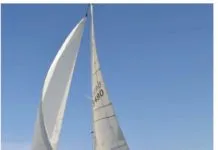

































The link has failed for “C&C 40 Construction Details”